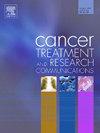靶向磷脂酰肌醇-3激酶(PI3K)和丝裂原活化蛋白激酶(MAPK)信号通路以增强局部晚期直肠癌的放化疗
IF 2.4
Q3 Medicine
引用次数: 0
摘要
局部晚期直肠癌对新辅助放化疗的反应并不统一。磷脂酰肌醇-3激酶(PI3K)和丝裂原活化蛋白激酶(MAPK)途径参与许多癌症的肿瘤发生和治疗耐药;因此,靶向这些途径可以增强对放化疗的反应。采用5-氟尿嘧啶(5-FU)、放射线、PI3K抑制剂copanlisib和/或MEK抑制剂refametinib联合治疗具有不同PI3K和MAPK突变背景的结直肠癌(CRC)细胞系(n = 10),并测量其对体外增殖的影响。BALB/c SCID小鼠植入了代表每种突变背景的CRC细胞系,用copanlisib和/或放化疗治疗,并监测肿瘤生长。在体外,PIK3CA突变细胞株对copanlisib最敏感(IC50=28 nM), KRAS突变细胞株对refametinib最敏感(IC50= 36 nM),而在9/10的细胞株中,copanlisib与refametinib联用具有协同作用。与单独使用5-FU放化疗相比,在5-FU放化疗中加入copanlisib可抑制细胞生长,这种作用在LS-1034 (KRAS突变)和Caco-2 (PIK3CA/KRAS野生型)细胞系中最为显著。体内coanlisib和5-FU放化疗减少了所有异种移植物模型的肿瘤生长,并增加了LS-1034和Caco-2异种移植物的总生存期。我们的研究结果表明,激酶信号通路的激活可能会调节结直肠癌中PI3K/MEK抑制剂的反应性。此外,与单独的5-FU放化疗相比,在5-FU放化疗中加入copanlisib可增强抗增殖性细胞毒作用,无论背景突变状态如何,这为该方案的进一步临床开发提供了支持。本文章由计算机程序翻译,如有差异,请以英文原文为准。
Targeting the phosphatidylinositol-3-kinase (PI3K) and mitogen activated protein kinase (MAPK) signalling pathways to enhance chemoradiotherapy in locally advanced rectal cancer
Responses to neoadjuvant chemoradiotherapy for locally advanced rectal cancer are not uniform. The phosphatidylinositol-3 kinase (PI3K) and mitogen-activated protein kinase (MAPK) pathways are involved in tumorigenesis and treatment resistance in many cancers; therefore, targeting these pathways could enhance response to chemoradiotherapy.
A panel of colorectal cancer (CRC) cell lines (n = 10) with varying PI3K and MAPK mutational backgrounds were treated with combinations of 5-Flourouracil (5-FU), radiation, the PI3K inhibitor copanlisib, and/or the MEK inhibitor refametinib, and their effects on proliferation in vitro were measured. BALB/c SCID mice were implanted with CRC cell lines representative of each mutational background, treated with copanlisib and/or chemoradiotherapy, and monitored for tumor growth.
In vitro, PIK3CA mutated cell lines were most sensitive to copanlisib (IC50=28 nM) and KRAS mutated cell lines were most sensitive to refametinib (IC50 = 36 nM), while the combination of copanlisib and refametinib was synergistic in 9/10 cell lines tested. The addition of copanlisib to 5-FU chemoradiotherapy inhibited cell growth compared to 5-FU chemoradiotherapy alone, an effect that was most notable in LS-1034 (KRAS mutated) and Caco-2 (PIK3CA/KRAS wild-type) cell lines. In vivo copanlisib and 5-FU chemoradiotherapy reduced tumor growth in all xenograft models and increased overall survival in LS-1034 and Caco-2 xenografts.
Our results suggest that activation of the kinase signalling pathway may modulate PI3K/MEK inhibitor responsiveness in colorectal cancer. Furthermore, the addition of copanlisib to 5-FU chemoradiotherapy resulted in an enhanced anti-proliferative cytotoxic effect compared to 5-FU chemoradiotherapy alone, regardless of the background mutational status, and supports further clinical development of this regimen.
求助全文
通过发布文献求助,成功后即可免费获取论文全文。
去求助
来源期刊

Cancer treatment and research communications
Medicine-Oncology
CiteScore
4.30
自引率
0.00%
发文量
148
审稿时长
56 days
期刊介绍:
Cancer Treatment and Research Communications is an international peer-reviewed publication dedicated to providing comprehensive basic, translational, and clinical oncology research. The journal is devoted to articles on detection, diagnosis, prevention, policy, and treatment of cancer and provides a global forum for the nurturing and development of future generations of oncology scientists. Cancer Treatment and Research Communications publishes comprehensive reviews and original studies describing various aspects of basic through clinical research of all tumor types. The journal also accepts clinical studies in oncology, with an emphasis on prospective early phase clinical trials. Specific areas of interest include basic, translational, and clinical research and mechanistic approaches; cancer biology; molecular carcinogenesis; genetics and genomics; stem cell and developmental biology; immunology; molecular and cellular oncology; systems biology; drug sensitivity and resistance; gene and antisense therapy; pathology, markers, and prognostic indicators; chemoprevention strategies; multimodality therapy; cancer policy; and integration of various approaches. Our mission is to be the premier source of relevant information through promoting excellence in research and facilitating the timely translation of that science to health care and clinical practice.
 求助内容:
求助内容: 应助结果提醒方式:
应助结果提醒方式:


